
Dimdima
Online Children's Magazine from India

Dimdima
Online Children's Magazine from India
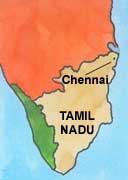
When Francis Day built Fort St. George, he was severely criticised for selecting a place which had no natural harbour. Ships had to anchor far out at sea and the passengers had to be brought ashore by masullas, boats made of planks tied together. However, by 1881, an artificial harbour was constructed north of the Marina beach. Today, Chennai is a major shipping centre.
At the south end of the Marina beach stands the Basilica of San Thome. It was built over the tomb of the apostle, St. Thomas Didymus, believed to have come to Chennai sometime during 52 AD. The beautiful stained-glass windows of the basilica portray the story of the saint, who first brought Christianity to India.
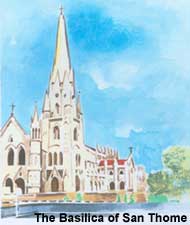
Quite close to San Thome, on the banks of the Adyar river, is the world headquarters of the Theosophical Society. The Society was founded by Madame Blavatsky and Col. Olcott in the USA and established at Adyar by Dr. Annie Besant, who played an important role in our country's struggle for freedom.
The Adyar library within the campus has one of the world's finest collections on Eastern civilization, with 165,000 books and almost 20,000 palm-leaf manuscripts.
In the Society's gardens are shrines of all the faiths and a giant banyan tree believed to be over 200 years old.
Nearly 3000 people can stand under its large canopy at a time.
Not far from the Theosophical Society stands one of the world's most renowned institutions of classical music and dance - the Kalakshetra. It was founded in 1936 by Rukmini Devi Arundale, a well-known Theosophist.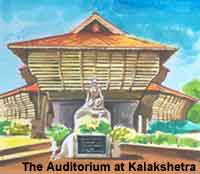
Until the early 1930's Bharatanatyam, the classical dance of Tamil Nadu, was performed only in temples by devadasis. It was not considered proper for girls from respectable families to learn this dance. Rukmini Devi Arundale succeeded in changing this attitude and made Chennai the centre of Bharatanatyam through her institution.
Further south is the Guindy National Park, one of the last refuges of the blackbuck in the country. The Raj Bhavan (Government House), the Indian Institute of Technology and the Guindy Engineering College, the oldest engineering institution in the country, are located here. Adjoining the park is the Madras Snake Park, founded by Romulus Whitaker, an American who settled in India. The park offers people a chance to see, touch and photograph the common snakes of India.
The city of Chennai includes places like Mylapore and Triplicane that date back to ancient times.
According to a legend, once when Siva and Parvati were engaged in a conversation, Parvati's mind wandered and she failed to hear what Siva was saying.
This angered Siva. He cursed her and turned her into a peacock, Parvati in the form of a peacock (mayil) performed penance till Siva restored her to her original form and beauty. The place where she did her penance came to be known as Mylapore, 'town of the peacock'.
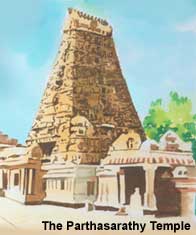
At Mylapore's Kapaliswara Temple, Parvati is worshipped in the form of a peacock in a shrine built in the shade of a sacred Punnai tree, believed to be one of the oldest trees in Chennai.
A little beyond the Kapaliswara Temple is the Luz Church, the oldest surviving European church in Chennai. It was built by the Portuguese between 1547 and 1582 in honour of Our Lady of Light. The story goes that once a few Portuguese sailors, who were shipwrecked, saw a bright light. They followed it and reached the shore safely. The light disappeared as soon as they reached land. The grateful sailors built the church at the place where they saw the light disappear.
Triplicane is a 1400-year-old settlement, famous for the Parthasarathy Temple, one of the city's oldest landmarks. The temple is dedicated to Lord Krishna in his role as Arjuna's 'charioteer' (hence Parthasarathy).
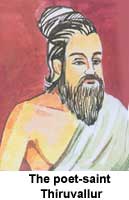
Beyond Triplicane to the east of Chennai is the Valluvar Kottam, a large auditorium dedicated to the saint, sage and poet,Thiruvallur, who lived in the first century BC. The 1330 verses of his Thirukkural, a treatise on righteousness, wealth and love have been inscribed on the granite pillars of the recently built auditorium.
There is a 33-metre-high temple chariot with a life-size statue of the poet seated inside, on the auditorium's terrace. A bas relief on the chariot's base depicts the 133 chapters of the Thirukkural. The auditorium is believed to be the largest in Asia with a seating capacity of 4000.
Another noteworthy place of worship is the Thousand Lights Mosque at the corner of Anna Salai (Mount Road) and Peters Road. It was named after the thousand oil-lamps that used to be lit in the mosque.
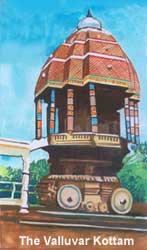
Chennai's suburb, Kodambakkam is known as the 'Hollywood of Southern India'. The film studios here make films in various South Indian languages and also dub foreign films into local languages.
Chennai's oldest and largest industrial area is Perambur. It is well-known for the Integral Coach Factory which manufactures railway coaches for the country. The factory's hospital is famous for heart surgery. Close to Perambur is the Sri Kasi Viswanathar Temple. which observes the tradition of keeping the Tirupati umbrellas for a night every year before they are taken to the temple of Lord Venkateswara.
This temple has a choultry, called the Tawker's choultry, attached to it. The Tawkers were one of the first Gujarati families to settle in Chennai in the 1760s. They were leading jewellers at one time. In 1804, two women of this family established a charitable trust out of which the temple was built.
Last updated on :7/1/2005
Dimdima is the Sanskrit word for ‘drumbeat’. In olden days, victory in battle was heralded by the beat of drums or any important news to be conveyed to the people used to be accompanied with drumbeats.
Bharatiya Vidya Bhavan
K. M Munshi Marg,
Chowpatty, Mumbai - 400 007
email : editor@dimdima.com
Bharatiya Vidya Bhavan
505, Sane Guruji Marg,
Tardeo, Mumbai - 400 034
email : promo@dimdima.com
Dimdima.com, the Children's Website of Bharatiya Vidya Bhavan launched in 2000 and came out with a Printed version of Dimdima Magazine in 2004. At present the Printed Version have more than 35,000 subscribers from India and Abroad.